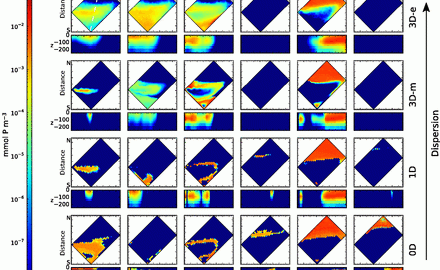Phytoplankton are an extremely diverse set of floating, microscopic organisms, which are freely transported by water movements (current, eddies, etc.) and make up the base of the oceanic food web. This work, published in the September issue of Limnology & Oceanography: Fluids & Environments, explores how their diversity is affected by dispersal by different scales of motions in the ocean.
Previous theoretical studies, based mostly on terrestrial ecosystems, have suggested that the number of phytoplankton types able to coexist at the same location should increase with increasing levels of dispersal.
In their new study, Marina Lévy (LOCEAN, Paris), and Oliver Jahn, Stephanie Dutkiewicz, and Mick Follows (EAPS, MIT), test this hypothesis for a realistic range of oceanic conditions using a set of computer simulations of phytoplankton ecology coupled with a turbulent ocean circulation model.
The Levy et al. results indicate that indeed locally, oceanic communities have enhanced diversity with increased dispersion, but the global community becomes dominated by a smaller number of phytoplankton types with larger home range areas. Dispersal due to oceanic eddies contributes significantly to these changes. Moreover, mixing of communities can only partially explain the increase in local coexistence, and the team believes that dispersal allows different phytoplankton types to become equally competitive.
Publication
Marina Lévy, Oliver Jahn, Stephanie Dutkiewicz and Michael J. Follows (2014), Phytoplankton diversity and community structure affected by oceanic dispersal and mesoscale turbulence, Limnology & Oceanography: Fluids & Environments, Volume 4: 67-84; Published August 8, 2014, doi: 10.1215/21573689-2768549
